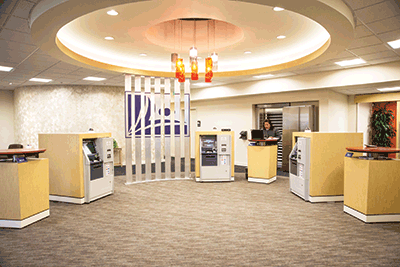“The death of the branch is greatly exaggerated.”
That is the opinion of several local financial experts, including Scott Miller, senior vice president of marketing at Riverview Community Bank.
“As long as people need people, you’re going to have branches,” said Miller.
Eric Petracca, chief financial officer for Lacamas Community Credit Union, put it this way:
“Why do we need coffee shops when we can get coffee at home? There’s still something about meeting with one of our knowledgeable employees and working through a financial wellness checkup that works really well in person.”
The conversation about the viability of the branch was sparked by a November SNL Financial report, which said U.S. banks had shuttered more branches than they opened in the third quarter of 2013. Many of the closures, said Miller, were a result of mergers and acquisitions, such as when Wells Fargo merged with Wachovia, or more locally, when Sterling Financial Corporation bought First Independent Bank.
Over the last 18 months in Clark County, said Miller, aside from the Sterling/First Indy consolidations, only one bank branch has closed – the Bank of America branch on Chkalov, in November. This branch, he said, was only 1.5 miles from a BOA branch on Mill Plain, and was difficult to access.
Petracca said Lacamas consolidated their Camas branch on 5th Ave. in August, because they had two full-service locations very close by (192nd Ave. in Camas and E Street in Washougal), with updated equipment, longer hours and more options to serve members.
Evolving, not dying
According to Bill Fulk, executive VP for Columbia Credit Union, the branch is evolving. Large brick-and-mortar facilities with tellers are being replaced with smaller branches. But while the square footage is shrinking, said Fulk, the branch staff tends to have a higher level of expertise, and can handle mortgages and investments as well as traditional branch transactions.
Miller said that traditional branches have been about 5,000 square feet, but that new branches may be as small as 1,000 to 2,500 square feet. Also, he said, fewer branches will be free standing facilities.
“Banks are finding that you can acquire three-fourths of the deposits of a free-standing branch at half the overhead” by locating a branch in a grocery store or shopping center, said Miller.
Colleen Boccia, senior VP of marketing at Columbia Credit Union, added that some financial institutions are centralizing staff, such as at Columbia’s 15-employee full-service call center in Vancouver.
The ambience of the branch is also changing. For example, while Riverview branches still feature traditional teller windows, each branch has a fireplace and comfortable chairs, creating a warm and inviting environment.
“Thinking about branches differently opens up possibilities for using these locations to serve members in new ways,” Petracca said. “It’s not about depositing a check anymore. It’s about connecting with people and offering innovative financial solutions.”
Technology and demographics
The advent of online and mobile banking is one of the drivers of the branch evolution. Miller reported that over the last three years, branch transactions have declined about 30 percent, as customers transfer money online, deposit checks with mobile phones and check balance by telephone.
“It’s a challenge to innovate by making the branch something that is still relevant in the world of mobile and electronic banking,” said Petracca.
He said that as they designed new Lacamas locations on 192nd Ave. and Andresen, they asked themselves, “What do members really come into the branch for?” The answer led them to create “financial centers,” which, said Petracca, are “more than just a branch.” Members are greeted as they walk in, and there’s no teller counter.
“Everything is comfortable, with couches, televisions, Wi-Fi and coffee,” said Petracca. “The entire experience is different than in a typical branch, and that’s by design.”
Mark Trupp, Wells Fargo’s local district manager, said that some Wells Fargo locations (none locally, however) are piloting a retail model, with greeters and roaming staff equipped with tablets.
Demographics, too, plays a role in defining the branch’s role and location.
Steve Kenny, president and CEO at Columbia Credit Union, said that they examine the demographics within a three-mile radius of a branch location. And when those demographics change, the branch must follow suit. For example, Columbia had a branch in the Tower Mall shopping center for 20 years. When the branch opened, said Kenny, the area was home to a health club, gas station and several other businesses. But a few years ago, the demographics changed, and Columbia relocated the branch to a LEED gold-certified building near the Grand Central Fred Meyer.
Trupp said that millennials (those born in or after the early 80s) come to a branch about 10 percent less than other generations, but they will comprise 55 percent of the workforce in the next ten years.
“We anticipate more foot traffic and client interaction,” said Trupp. “People still want to deal with people.”
Overall, banks and credit unions remain optimistic about the future of branches.
“Good customer service never goes out of style,” said Lindsey Salvestrin, Columbia Credit Union’s senior VP of service delivery and project management. “But we need to provide technology that enables members to bank however, wherever, whenever they want.”
Miller said that in a survey of 400 consumers in Clark County, more than 50 percent wanted “to know there is a banker they can talk to face-to-face.” Similarly, Trupp reported that 50 percent of clients with direct deposits visit a branch at least once every six months.
According to Petracca, the trend is to use branches not just for transactions but for more complex financial solutions.
“We call it ‘building relationships,’” he said. “And that’s tough to do through a mobile app.”



